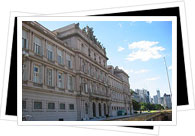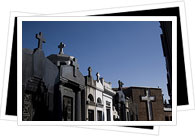
The Plaza de Mayo is a good place to start your exploration of Buenos Aires as it is well placed in the centre of the city. As well as relaxing in the square with the Porteños, you can visit the Casa Rosada. With its dusty pink facade and bright white balconies, this is the spot from which many important speeches have been made, including those by Perón and Evita. Today it houses presidential offices and a small museum. The square is also flanked by the Catedral Metropolitana - an unusual design for a cathedral with its carved pediment and stone pillars. The sculpted scene depicts Joseph and Jacob's reunion in Egypt. This is also where you will find the tomb of Argentina's national hero - General José de San Martín. Also in the square is the attractive domed Cabildo, or Town Hall. Every Thursday afternoon the plaza is filled by the mothers of those who disappeared during the dictatorship of the 1970's and 80's (see Argentina History section for more information). They wear white headscarves and march around the small obelisque in front of the Casa Rosada to plead recognition of all those who 'disappeared' during those dark years.
Nearby Manzana de las Luces is Buenos Aires' oldest church, built in 1730 it was occupied by the Jesuits. In 1912 a series of underground tunnels were found underneath in which goods used to be smuggled out to the river plate.
Buenos Aires is brimming with eclectic architecture and taking a stroll is a really good way to soak up the city's diversity. In the northern areas you will find lots of pristine examples of colonial architecture where BA's richest residents reside. An exquisite example is the Palacio San Martín where the Anchorena family once lived - this showy French style mansion was built in 1905 and looks out over the pretty Plaza San Martín (Retiro district). The northern part of the city is also the best place to chill out in one of the immaculately landscaped parks, especially nice is the Parque 3 de Febrero (Palermo district) which even comes complete with parrots! Heading down south you will reach Buenos Aires' oldest areas, Montserrat and San Telmo. Once dripping with the same grandeur found in the north a bout of Yellow Fever in 1871 sent all the aristocracy running northwards, leaving the area to the influx of newly arrived immigrants. While many of the old mansions are still standing, what remains is characterised by crumbling elegance. La Boca is also famous for its' architecture, but this time for the tiny multicoloured houses which line the streets.
There are good museums and a huge number of top notch art galleries scattered all over the city, especially in the central and northern areas, check out the Museums in Argentina section for a full run-down of the most popular ones. Most notable is the Museo de Arte Hispanoamerico (Retiro district) and the Museo Nacional de Bellas Artes (Recoleta district) which showcases mainly European works of art. The Museo de la Inmigración (city centre) is the best place to read up on how Buenos Aires came to be such a culturally diverse place. Eduardo Costantini's gallery, Museo de Arte Latinoamericano de Buenos Aires, is an absolute must for art lovers.

The Argentine capital also has a couple of rather unusual but very popular attractions with tourists and Porteños alike. Juan Perón was finally laid to rest in the understated Cementerio de Chacarita in the western quart of the city. Despite attacks by vandals who broke the crypt and cut off Perón's hands in 1987, he still lays there today. However, it is surprising that Porteños seem to pay more attention to the tomb of famous Tango singer Carlos Gardel which is also found in this cemetery. Evita's remains can be found in the Recoleta cemetery which ironically contains the tombs of the richest Argentine citizens. After years of controversy and deception, Evita Perón was finally allowed to be buried there in her family crypt. The wealthy Argentine families were against this decision and her remains had to be buried over 25 feet underground and protected by steel plating so that they could not be vandalised as her husband's were.
If you fancy escaping the bustle of the city, make like a true Porteñan and head to the Reserva Ecológica Costañera Sur - an idyllic spot abundant in natural beauty and containing over 200 species of bird - all just a stones throw from the city centre.